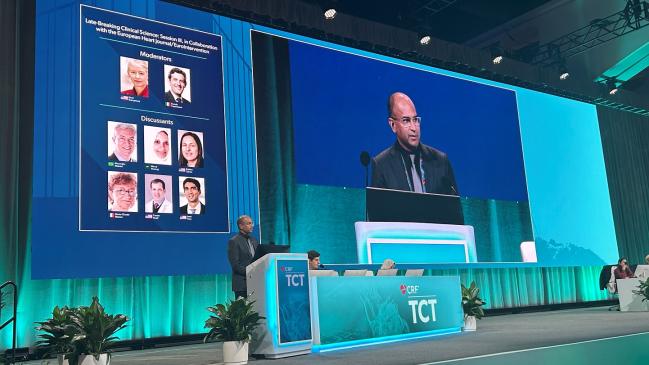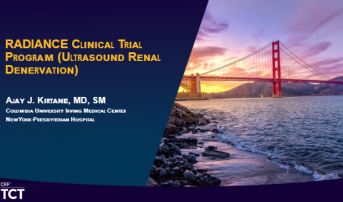RADIANCE: 'Modest' Renal Denervation Effect Remains at 6 Months
Even after medical therapy was intensified in both groups, fewer medications were needed after denervation than after sham.

SAN FRANCISCO, CA—Even after antihypertensive agents were added back during the course of the RADIANCE trials, medication burden remained lower in the renal denervation arm than in the sham arm through 6 months, according to a pooled analysis.
And after accounting for the differential use of drugs to control hypertension between months 2 and 6, a significant blood pressure-lowering effect of denervation could still be seen, Ajay Kirtane, MD (NewYork-Presbyterian/Columbia University Irving Medical Center, New York, NY), reported last week at TCT 2023. The results were published simultaneously online in Circulation.
The mean drop in daytime systolic BP over 6 months, for example, was 3.0 mm Hg greater in the denervation versus sham arm in a model adjusting for medications (P = 0.033). Declines in home and office systolic BP, respectively, were 5.4 and 5.2 mm Hg greater in the denervation patients, an effect Kirtane characterized as “modest.”
“This is not a dramatic effect in terms of blood pressure-lowering,” Kirtane acknowledged at a press conference, pointing out, however, that despite the availability of effective medications and lifestyle behaviors to lower BP, control rates hover around only 60%. If conventional approaches fail “and patients are uncontrolled then at that point, denervation might be considered,” he said.
Roxana Mehran, MD (Icahn School of Medicine at Mount Sinai, New York, NY), who moderated the press conference, said that physicians often do a poor job in treating hypertensive patients and getting their BP under control. In that context, renal denervation “could have an important impact,” she said.
One of her concerns, however, is the durability of the results, an issue Kirtane said is difficult to study because it would be unethical to leave patients randomized to the sham group purposefully uncontrolled for more than a few months. Once medical therapy is intensified in that group, it confounds any comparison with denervation because it is effective in reducing BP, narrowing differences with the active treatment arm.
For drug treatment to work in these hard-to-treat patients, however, “what we had to do is bring patients back every month and escalate their regimen in a protocol-driven way,” Kirtane said. “So no one is saying here that [denervation] is better than medications. . . . Medications work really well. It’s just a matter of trying to implement things in an adherence-independent way, and that’s where I think it’s important that if you can do [the procedure] once and it stays, that’s great. If you have to do the procedure every couple years, I think that’s a much less compelling alternative.”
Pooled RADIANCE Results
Renal denervation appears to be on the verge of clinical relevance following a US Food and Drug Administration advisory committee provided a positive review of the ultrasound-based Paradise system (ReCor Medical) used in the RADIANCE trials (the Symplicity Spyral system from Medtronic didn’t fare as well).
Three sham-controlled trials met their primary endpoints, showing that denervation with the Paradise system lowered BP through 2 months in patients with either mild-to-moderate hypertension on a background of no antihypertensive medications (RADIANCE II and RADIANCE-HTN SOLO) or resistant hypertension on a background of three drugs in a single combination pill (RADIANCE-HTN TRIO).
This is not a dramatic effect in terms of blood pressure-lowering. Ajay Kirtane
At TCT, Kirtane presented a pooled patient-level analysis of the three RADIANCE trials to capture the effect of escalating medical therapy from months 2 to 6 (ie, after the assessment of the primary endpoints of the trials at 2 months). REQUIRE, a fourth trial of ultrasound-based denervation that was designed for regulatory approval in Japan but failed to demonstrate a significant difference in BP reduction between active treatment and the sham procedure, was not included in the analysis.
“The lack of blinding of treating physicians, missing standardization of the [denervation] procedure, and medication escalation favoring increased adherence in patients within the sham group contributed to the unexpectedly large BP-lowering effect observed within the sham group of the REQUIRE trial,” Kirtane and his colleagues note in their paper.
Within the RADIANCE trials, after 2 months, patients in both groups recorded their home BP and attended office visits monthly, with protocol-guided drug escalation if they remained uncontrolled. The trials were not designed to detect differences between the denervation and sham arms at 6 months, so the results at 6 months should be considered descriptive only, Kirtane said.
The pooled analysis included 293 patients randomized to denervation and 213 to a sham procedure, with a mean patient age of 54 years; 30% of participants were women.
At initial screening, mean daytime ambulatory BP was 150.3/93.6 mm Hg in the denervation arm and 150.8/93.8 mm Hg in the sham arm. As reported previously, denervation led to a 5.9-mm Hg greater drop in daytime ambulatory systolic through 2 months (P < 0.0001).
Extending follow-up from 2 to 6 months, when patients in both groups were having their medications uptitrated to achieve BP control, full adherence to antihypertensive regimens was about 83% in both groups.
I think that this will put a spotlight on hypertension and better blood pressure control for everyone. Debbie Cohen
After 2 months, Kirtane said, “if there was an effect of denervation, you would hypothesize that there’d be more medicines added to . . . the sham group compared to the denervation group, and that’s exactly what this pooled analysis shows.”
The mean number of medications added was 1.1 in the renal denervation arm and 1.3 in the sham arm, with changes in defined daily dose and antihypertensive medication load index also indicating less need for medication after denervation (all P = 0.001). The proportion of patients who had at least one medication added was significantly lower in the denervation group (66.3% vs 77.0%; P = 0.002). These differences were enhanced in an analysis restricted to patients who had at least a 10-mm Hg reduction in home systolic BP.
Through 6 months, declines in BP were observed in both the denervation and the sham arms, with little difference between groups at the end of that time period before adjustment for medication changes. After accounting for those differences in drug therapy, however, a significant advantage for denervation was evident.
“We didn’t really expect necessarily to see a difference in both groups at 6 months, because we were trying to control everybody, but you still see some residual effect,” Kirtane said, adding that the safety of the procedure was “quite good.”
Denervation Won’t Work On Its Own
Kirtane pointed out that even though the BP-lowering effect of the procedure could still be detected at 6 months, most patients in both groups still required additional medications. “It’s not like you’re going to control everybody with renal denervation,” he said. “You’re going to have to add medications to denervation to try to control patients.”
Generally, about two-thirds of patients have been shown to be responders to renal denervation—with at least a 5-mm Hg drop in systolic BP—and the rest have been nonresponders. Unfortunately, there are no good predictors of who will respond, much like what has been seen with antihypertensive medications, Kirtane said.
Therefore, rolling out denervation in an unfettered fashion “wouldn’t really be in anyone’s interest,” he said. He added that if renal denervation were to be approved, his approach would be to try conventional means first—lifestyle modification and medications—and then if “the blood pressure’s still elevated, particularly if they’re at risk, then I would discuss this as a potential option to treating them. But I’d be very honest about the fact that they might not respond.”
Debbie Cohen, MD (University of Pennsylvania, Philadelphia), who was the lead discussant following Kirtane’s presentation, said “renal denervation’s not for everybody with hypertension, for sure, and we do have really effective pharmacotherapy, but I think that this will put a spotlight on hypertension and better blood pressure control for everyone. And I think at the end of the day, this will serve everyone well and improve hypertension control.”
Wayne Batchelor, MD (Inova Heart and Vascular Institute, Falls Church, VA), a panelist at the press conference, called the pooled results “very reassuring,” adding that longer-term follow-up will be needed.
It’s also important to understand which patients were included in the RADIANCE trials, he said, noting that only 30% of participants were women and just 16% were African American. Thus, additional studies should expand the reach of denervation “to those who actually could stand to even benefit incrementally the most—in particular, resistant patients such as African Americans and others.”
Nonetheless, Batchelor said, “this is an important addition to our knowledge base, and it’s nice to see the consistency across all the severities of hypertension.”
Todd Neale is the Associate News Editor for TCTMD and a Senior Medical Journalist. He got his start in journalism at …
Read Full BioSources
Azizi M, Sharp ASP, Fisher NDL, et al. Patient-level pooled analysis of endovascular ultrasound renal denervation or a sham procedure at 6 months following medication escalation: the RADIANCE clinical trial program. Circulation. 2023;Epub ahead of print.
Disclosures
- The RADIANCE trials were funded by ReCor Medical.
- Kirtane reports institutional funding (including research grants and fees for consulting and/or speaking) to Columbia University and/or the Cardiovascular Research Foundation from Medtronic, Boston Scientific, Abbott Vascular, Abiomed, CSI, CathWorks, Siemens, Philips, and ReCor Medical; consulting fees from Neurotronic; and travel expenses/meals from Medtronic, Boston Scientific, Abbott Vascular, Abiomed, CSI, CathWorks, Siemens, Philips, ReCor Medical, Chiesi, OpSens, Zoll, and Regeneron.






Comments